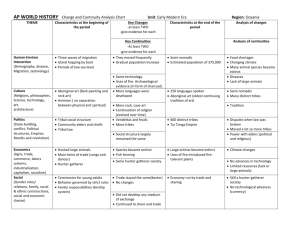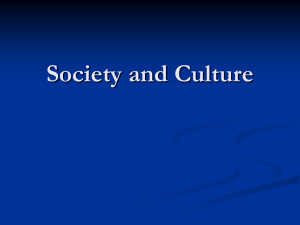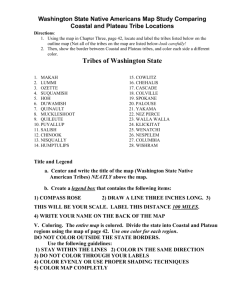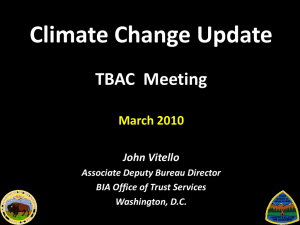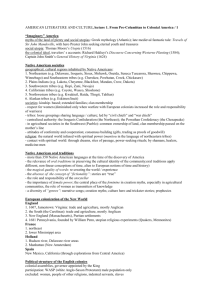Climate Change and Human Health
advertisement
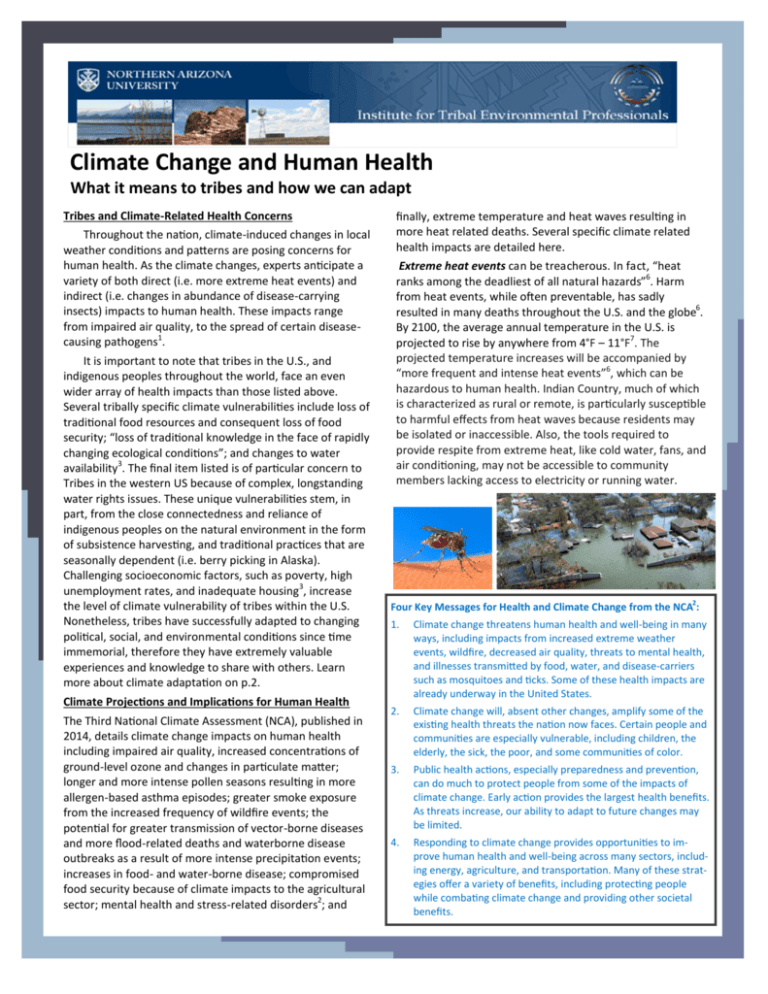
Climate Change and Human Health What it means to tribes and how we can adapt Tribes and Climate-Related Health Concerns Throughout the nation, climate-induced changes in local weather conditions and patterns are posing concerns for human health. As the climate changes, experts anticipate a variety of both direct (i.e. more extreme heat events) and indirect (i.e. changes in abundance of disease-carrying insects) impacts to human health. These impacts range from impaired air quality, to the spread of certain diseasecausing pathogens1. It is important to note that tribes in the U.S., and indigenous peoples throughout the world, face an even wider array of health impacts than those listed above. Several tribally specific climate vulnerabilities include loss of traditional food resources and consequent loss of food security; “loss of traditional knowledge in the face of rapidly changing ecological conditions”; and changes to water availability3. The final item listed is of particular concern to Tribes in the western US because of complex, longstanding water rights issues. These unique vulnerabilities stem, in part, from the close connectedness and reliance of indigenous peoples on the natural environment in the form of subsistence harvesting, and traditional practices that are seasonally dependent (i.e. berry picking in Alaska). Challenging socioeconomic factors, such as poverty, high unemployment rates, and inadequate housing3, increase the level of climate vulnerability of tribes within the U.S. Nonetheless, tribes have successfully adapted to changing political, social, and environmental conditions since time immemorial, therefore they have extremely valuable experiences and knowledge to share with others. Learn more about climate adaptation on p.2. Climate Projections and Implications for Human Health The Third National Climate Assessment (NCA), published in 2014, details climate change impacts on human health including impaired air quality, increased concentrations of ground-level ozone and changes in particulate matter; longer and more intense pollen seasons resulting in more allergen-based asthma episodes; greater smoke exposure from the increased frequency of wildfire events; the potential for greater transmission of vector-borne diseases and more flood-related deaths and waterborne disease outbreaks as a result of more intense precipitation events; increases in food- and water-borne disease; compromised food security because of climate impacts to the agricultural sector; mental health and stress-related disorders2; and finally, extreme temperature and heat waves resulting in more heat related deaths. Several specific climate related health impacts are detailed here. Extreme heat events can be treacherous. In fact, “heat ranks among the deadliest of all natural hazards”6. Harm from heat events, while often preventable, has sadly resulted in many deaths throughout the U.S. and the globe6. By 2100, the average annual temperature in the U.S. is projected to rise by anywhere from 4°F – 11°F7. The projected temperature increases will be accompanied by “more frequent and intense heat events”6, which can be hazardous to human health. Indian Country, much of which is characterized as rural or remote, is particularly susceptible to harmful effects from heat waves because residents may be isolated or inaccessible. Also, the tools required to provide respite from extreme heat, like cold water, fans, and air conditioning, may not be accessible to community members lacking access to electricity or running water. Four Key Messages for Health and Climate Change from the NCA2: 1. Climate change threatens human health and well-being in many ways, including impacts from increased extreme weather events, wildfire, decreased air quality, threats to mental health, and illnesses transmitted by food, water, and disease-carriers such as mosquitoes and ticks. Some of these health impacts are already underway in the United States. 2. Climate change will, absent other changes, amplify some of the existing health threats the nation now faces. Certain people and communities are especially vulnerable, including children, the elderly, the sick, the poor, and some communities of color. 3. Public health actions, especially preparedness and prevention, can do much to protect people from some of the impacts of climate change. Early action provides the largest health benefits. As threats increase, our ability to adapt to future changes may be limited. 4. Responding to climate change provides opportunities to improve human health and well-being across many sectors, including energy, agriculture, and transportation. Many of these strategies offer a variety of benefits, including protecting people while combating climate change and providing other societal benefits. Impaired air quality Warmer temperatures are expected to result in increases in ground-level ozone, and changes in particulate matter concentrations and allergen prevalence1. In addition, climate change is altering global atmospheric circulation patterns, which are in turn altering the meteorological factors that serve to disperse pollutants8. This means that certain regions of the world, including India, Mexico, and the western U.S. are likely to experience greater atmospheric stagnation and therefore, more buildup of air pollutants8. The distribution and abundance of disease vectors are directly influenced by climate. More broadly, climate can “influence vector-borne disease risk by impacting the abundance and distribution of tick or mosquito vectors, the percent of vectors infected with disease agents, the abundance and distribution of animal reservoirs, the presence of suitable habitat for these vectors, and people’s behaviors that bring them into contact with infected vectors5.” Not only does climate impact disease agents, like mosquitos, it may also influence human behavior in ways that bring people into greater contact with vectors5. Impacts to food security/traditional indigenous diets Environmental Health Perspectives published a graphic9 which depicts the varied ways in which climate is impacting tribes throughout the nation. Across all regions of the country, tribes are finding that abundance and accessibility of food and water resources are changing. As the graphic indicates, southeastern tribes are anticipating coastal flooding that will damage citrus crops, tribes in the Great Lakes region are concerned about the loss of subsistence species like moose and trout, and in the Pacific Northwest, tribes are contending with changes to aquatic ecosystems that threaten culturally significant fish species. What is the cumulative effect of these climate-driven health concerns? The World Health Organization (WHO) estimates that globally “the direct damage costs to health (i.e. excluding costs in healthdetermining sectors such as agriculture and water and sanitation), is estimated to be between US$ 2-4 billion/year by 2030”4. Even without taking into consideration the myriad impacts of climate change on food systems and water resources, the projected health expenses attributable to climate change are immense. What Tribes Can Do: There are very real and practical steps that tribes can take to safeguard their communities from climate change impacts. Air Quality Policy—The WHO explains that “reducing emissions of greenhouse gases through better transport, food and energy-use choices can result in improved health, particularly through reduced air pollution”4. Both locally and nationally, protective air policies can be adopted to improve air quality and mitigate climate change. Adaptation Planning—One very important step for helping tribal communities with climate adaptation is for tribal departments to engage in strategic and emergency planning, incorporating climate projections into those plans, and developing and implementing strategies that will reduce climate change impacts and vulnerabilities and increase the tribe’s capacity to cope with the impacts. For more on tribal climate adaptation efforts, visit: http://www4.nau.edu/ tribalclimatechange/tribes/index.asp Community based initiatives and partnerships—Tribal community members are an outstanding resource both as stewards of the environment and caregivers for one another. Examples abound of tribes launching successful community outreach campaigns in which they educate the public and gain buy-in for healthy and conscientious practices. Tribes may also choose to work with partners, like Indian Health Services community health representatives, who can go into communities and provide one-on-one guidance to tribal members on climate and health related issues, like what to do in an extreme heat event. Resources EPA - Climate Change Human Health http://www.epa.gov/climatechange/impacts-adaptation/health.html USGCRP - NCA (2014) Human Health Sector, http://nca2014.globalchange.gov/report/sectors/human-health USGCRP - NCA (2014) Indigenous Peoples, Lands, & Resources http://nca2014.globalchange.gov/report/sectors/indigenous-peoples World Health Organization - Climate Change and Health (2014) http://www.who.int/mediacentre/factsheets/fs266/en/ Minnesota Department of Health - Vector-Borne Diseases and Climate Change http://www.health.state.mn.us/divs/idepc/dtopics/vectorborne/climate.html California Environmental Protection Agency - Preparing California for Extreme Heat: Guidance and Recommendations (2013) http://www.climatechange.ca.gov/climate_action_team/reports/Preparing_California_for_Extreme_Heat.pdf EPA - Future Climate Change http://www.epa.gov/climatechange/science/future.html Nature Climate Change - Occurrence and persistence of future stagnation (2014) http://www.nature.com/nclimate/journal/v4/n8/full/nclimate2272.html Environmental Health Perspectives - Climate Change and Health: A Native American Perspective (2010) http://oceanservice.noaa.gov/education/pd/climate/teachingclimate/climate_change_and_health_a_native_american_perspective.pdf Photos courtesy of Ready.gov (flood photo, p.1), Michigan Department of Environmental Control (mosquito, p.1), NASA SciJinks (smog photo, p.2). For more information, contact: Sue Wotkyns, Climate Change Program Manager, Institute for Tribal Environmental Professionals, susan.wotkyns@nau.edu Cristina Gonzalez-Maddux, Research Specialist, Institute for Tribal Environmental Professionals, cristina.gonzalez-maddux@nau.edu This fact sheet was developed with support from the USDA Forest Service’s Rocky Mountain Research Station. January 2015
